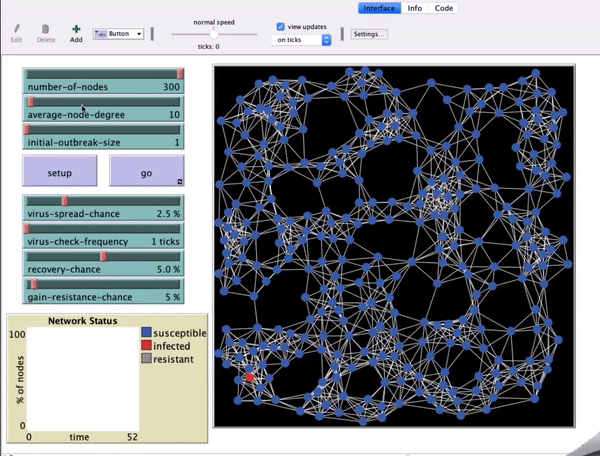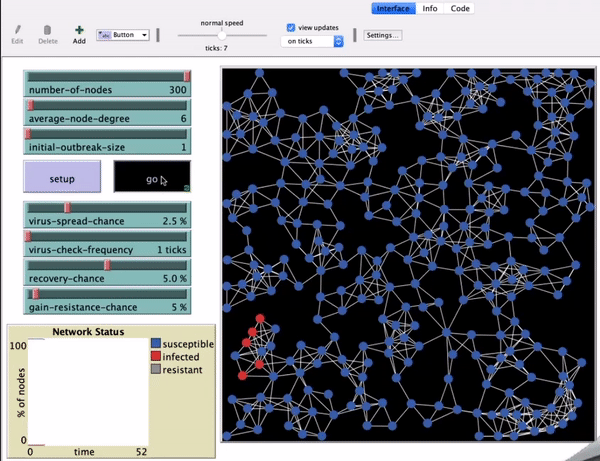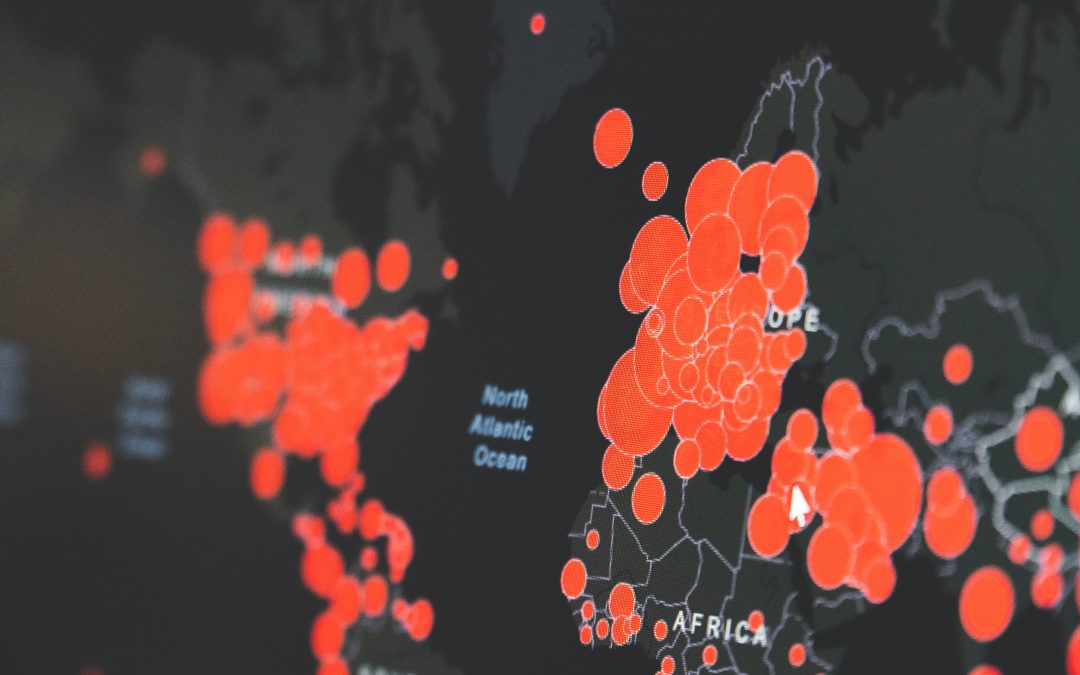Computational models can show how processess will behave in non-linear ways, but these demonstrations are very simplistic and do not consider all factors that influence the dynamic in reality.
Computational models and huge amounts of available data allow us to predict the outbreak of COVID-19 globally and prepare respective measures to react to this crisis. Policy-makers, journalists and individuals refer to such calculations on a daily basis and they are prominently present in the public discourse. What is often not left out of the debate are uncertainties, limitations and effects that communication about these predictions brings about for the society. Elephant in the lab asked the associate professor and managing director of the Groningen Center of Social Complexity Studies Wander Jager to explain risks and unintended effects of computational modelling in times of crises. He has been studying social dynamics in networks for more than 20 years and is currently part of an international university consortium preparing the online course “Action for computational thinking in social sciences”.
For you as a computational social scientist it must be quite an interesting time from a professional point of view. Currently, you are working on the materials for the part of a bigger online course on computational social science called “The Networks Connecting People: How humans spread disease, fake news, and good ideas”. What do you learn as an expert in these times?

Wander Jager
These are, of course, very exciting times and actually just a couple of weeks ago I was teaching in the University of Groningen about contagion dynamics and just two weeks later the Corona virus started spreading in China. Obviously, I started following this spread and it didn’t come as a surprise that we have now this pandemic going all over the world. It is really fascinating to see the difference among countries, the stages and changing public attitudes. In the beginning, a lot of people here were thinking – Oh, it’s just China. That is far away. Then people found it very difficult to realize how quickly a virus can spread if we are so connected.
What we all can learn now is, how important inter- and transdisciplinary collaboration is when addressing such complex challenges. You need to understand what’s happening from different perspectives. First of all, you need virologists that know very much about the specifics of the behaviour of particular viruses, you need network specialists that know about how this virus can spread through different network structures and what kind of policies you can use that would break down parts of the network and would try to control the spread. You also need people that know how to share information and how to inform the population about the best strategies at any given time to deal with that. You probably need people from the law that can tell you what kind of policies can be implemented and which policies are not compatible with fundamental human rights.
Currently, we hear a lot about the necessity to slow down the spread of the virus. Could you explain why this is important and how respective measures can be planned?
The important thing about computational models is that they show how such processes can behave in non-linear ways. Very often people are not impressed by hearing limited numbers and it’s very difficult to imagine how a virus can explode starting with just a few cases and turning into a global pandemic. So, I think having a tool that very clearly demonstrates how these processes work contributes to people’s awareness of the scope of the threat. Also, to their understanding of what kind of policies might be effective in basically fighting this battle against an uncontrolled spread of the disease.
Let me explain to you in a nutshell how this works using one of the standard models from the open source Netlogo library. Mind this is a very basic model on contagion dynamics, and it does not capture the specifics of the coronavirus, global networks and behavioural responses. But it does illustrate some relevant dynamics of contagion. On the left (Pic.1) we see a network of 300 connected people (blue dots) and their connections to other people (white lines). Each of them has in average contact with ten people and at the beginning only one person is infected (red dot). Most of the people are susceptible to the disease and nobody is resistant. On the right side (Pic.2 you see the same setting with one difference: each person has on average six contacts.
 |
 |
| Pic.1. Each person has ten contacts on average: the virus spreads very fast. | Pic.2. Each person has six contacts on average: the virus spreads slowly. |
What is “herd immunity” and can a complete lock-down stop the pandemic?
What’s often being discussed these days, is whether we can slow down this virus by social distancing. If we go down from ten contacts per person to six the network becomes less dense than the previous one and there are fewer contacts between people (Pic. 2). The spread of the virus is now way slower in this situation, and the peak of infections that we saw in the earlier simulation now is flattening out. Moreover, because of the fewer connections between people, resistant people are more effective in blocking the spreading. If you have a critical proportion of the population that have lived through the infection and became resistant, the outbreak will die out. With fewer contacts between people, a smaller proportion of resistant people is needed to have this herd immunity. When people are socially distancing and the outbreak has stopped, you have to be careful in expanding your social network, because the population remains vulnerable for an outbreak. This makes controlling the virus a sort of balancing act.
Another alternative is having a complete lockdown (Pic.3) – so people would have no contacts at all. If we model this, we see that nothing happens – the spread stopped. It sounds like a very attractive scenario, but mind that as soon as we start having contact again everybody is still susceptible for the virus and the virus can spread very fast. So, it might be a smart strategy at this moment to let this virus spread in a controlled way through society to make sure that herd immunity is built up and that the society becomes resistant to the virus. This might look like an optimal strategy, but even an optimal strategy may result in a lot of victims. Obviously, it all depends very much on the characteristics of the virus: will it mutate, how contagious is it really, how long are people resistant etc. etc., so it is a very complex and uncertain situation. It is wise to be as careful as possible, and many scientists are working hard on a vaccin, which is basically the best cure to protect in particular the vulnerable people. If we succeed, by social distancing, to seriously slow down this outbreak, or even halt it, we buy time for the development of a vaccin.

Pic.3. Complete lockdown.
Even now, if you look at the absolute numbers in many countries, they are often not yet shocking. On the individual level, one might think that the possibility to get infected is quite low and continue to live their usual lifestyles. What can computational modelling of the pandemic spread teach us about individual responsibility in a community?
For the individual this means that everyone has a kind of responsibility to reduce the number of physical interactions that he or she has with other people. It’s very difficult to control this only by policy measures and a complete lockdown as we see has its disadvantages, especially if it takes a long time. Because much of the required action in social distancing has to come from ourselves, the people, controlling this top-down throught policy is a hard thing to do. You have to realize that for most young and healthy people this virus is not that dangerous, they will have a serious flu, but not more than that, you grow over it. So many people think light about this, and even organised private corona parties because the bars were closed. But even people that will be hardly hit by the virus play a role in spreading the virus. And this is the important part, if one wants to protect his or her grandparents or people with asthmatic or heart conditions, they have to take personal responsibility and really reduce the number of personal contacts. If we do this together basically as a society at the grassroots level then we, as a collective, are capable of slowing down the spread of this virus and protecting vulnerable people. And I hope this goes slowly enough, so scientists working on vaccines will be successful providing one in time also to protect the more vulnerable people at a later stage, because that is really a big challenge.
What are the uncertainties that modelling brings about?
It’s a very complex situation and very tiny causes can have large effects; this is typical for complex systems as I’ve shown in the model. These effects are predictable, you can calculate and demonstrate the virus spread chance. What’s necessary to keep in mind is that such demonstrations are very simplistic at this moment. We know that in reality there are many more factors that need to be considered. It’s already visible, for example, that younger children are less strongly affected from the infection, the weather has to do with it, as UV light and humidity have an influence on how long the virus remains present on different types of surfaces (e.g., the nozzle at the petrol station). All these factors are not included in these simplistic models. Just think of the weather, which is quite unpredictable, but has an influence on both the survival of the virus as the tendency of people to go out to the parks.
I’m glad that now a lot of governments in countries all over Europe and the world understand the dynamics of the situation quite well. The Dutch prime minister when giving a speech on the measures the authorities took to control the spread of this disease admitted that they don’t know how this develops. It’s necessary to communicate the truth and stay very adaptive: if it goes faster, we have to take additional measures and if it goes slower, we can release a bit of tension, so that people can perhaps go back to shopping. This shows that they are aware of the complexities of this outbreak.
How do these uncertainties affect social behaviour?
In the ACTISS on-line course about computational social science we will also address these fundamental uncertainties and social dynamics in situations where a lot of people are interacting. And we also focus on what is being exchanged between people, such as ideas and opinions. A better understanding of these dynamics helps in developing policies that adapt and try to find a balance. However, due to the complex dynamics classical prediction is not possible in such systems. I often say, when you make a forecast of the weather the weather doesn’t listen to that. But if you make a forecast on how this virus will spread that will also have an impact on how people will behave. The prediction itself will have an impact on the spreading of the disease and that gives basically an additional layer of complexity to these processes.
One nasty outcome of such interaction is hoarding – we’ve seen the situation in supermarkets, when hardly any vegetables, bread and toilet paper could be found. And there were pictures of empty shelves circulating through the (social) media that made people nervous and only increased hoarding. Even when sufficient supplies are available, this hoarding may overburden logistic operations, and cause problems that could be avoided. This is also an example of social influence through networks playing an important role here. I think it’s critical to reflect on what is smart and appropriate behaviour in these exceptional circumstances.
This imposes a very big challenge for social scientists, who have to think about ways of preventing these kinds of self-fulfilling prophecies becoming real. And I think that good information can play an important role on the one hand, and on the other hand as a supermarket you can also be prepared when you see something like this coming and have some additional stocks that you know you will not confront people with empty shelves, because empty shelves result in panic; you want to avoid that. It seems that some modern automated just-in-time logistic operations should be made more robust for these disturbances.
In my opinion, it is very important to be aware that there are fundamental uncertainties in complex systems like this COVID19 outbreak, and that despite an impressive body of growing scientific knowledge, a precise prediction of the outcomes and the perfect policy response are not possible to identify. We do know however that an important key to the solution resides in reducing our physical contacts, even through surfaces on which the virus can reside. So be aware, wash your hands, and meet on-line! As a community we can take care for each other through these simple measures. And help the vulnerable people where you can, we can come through this pandemic having a stronger sense of community!
An interview by Nataliia Sokolovska

